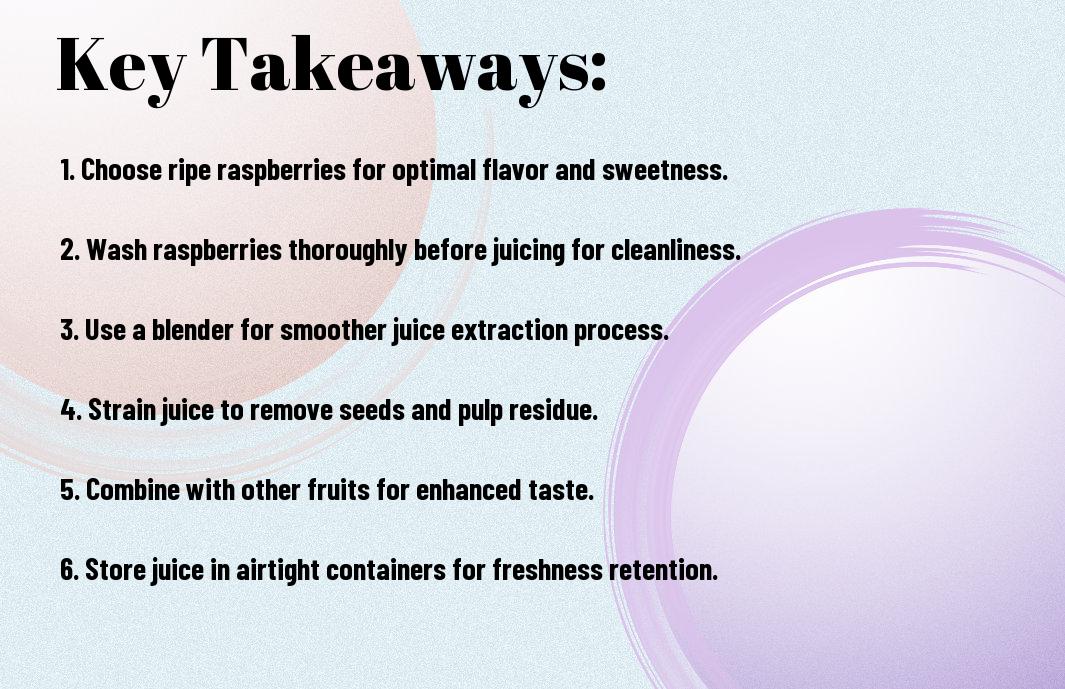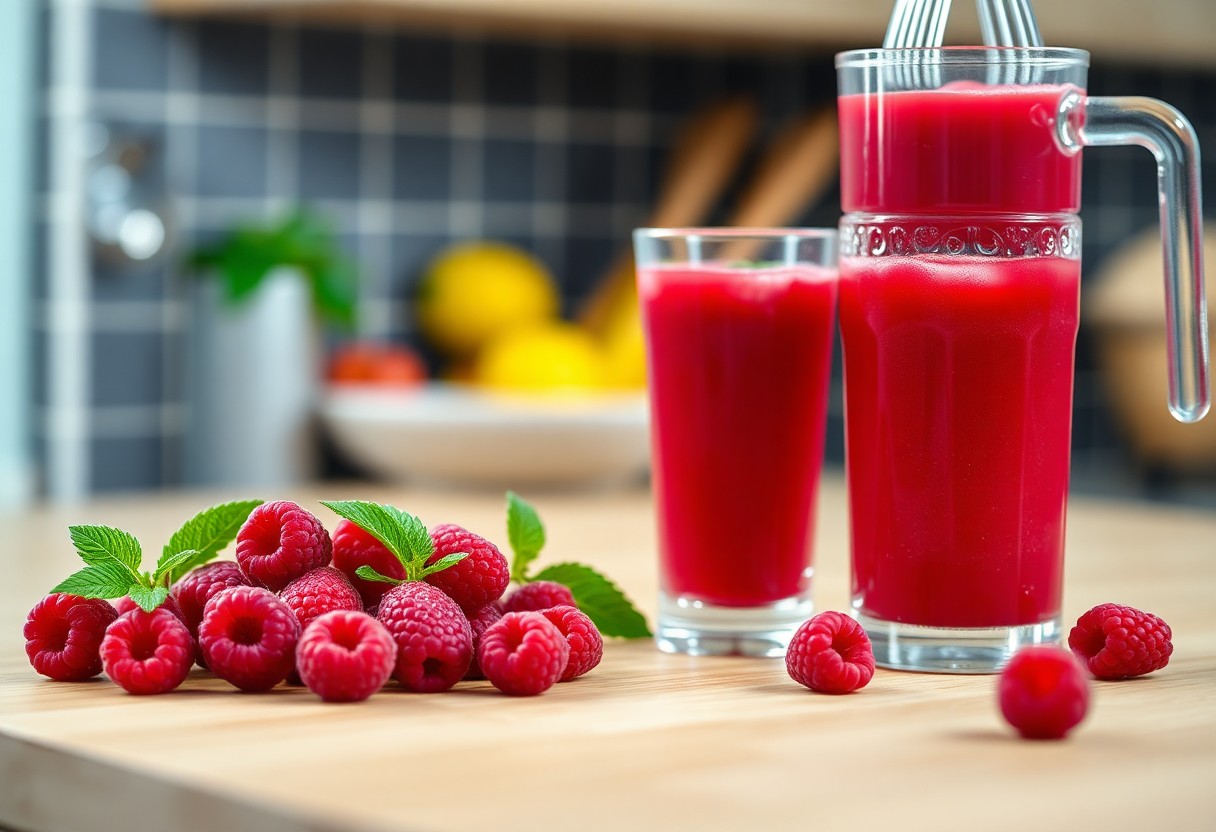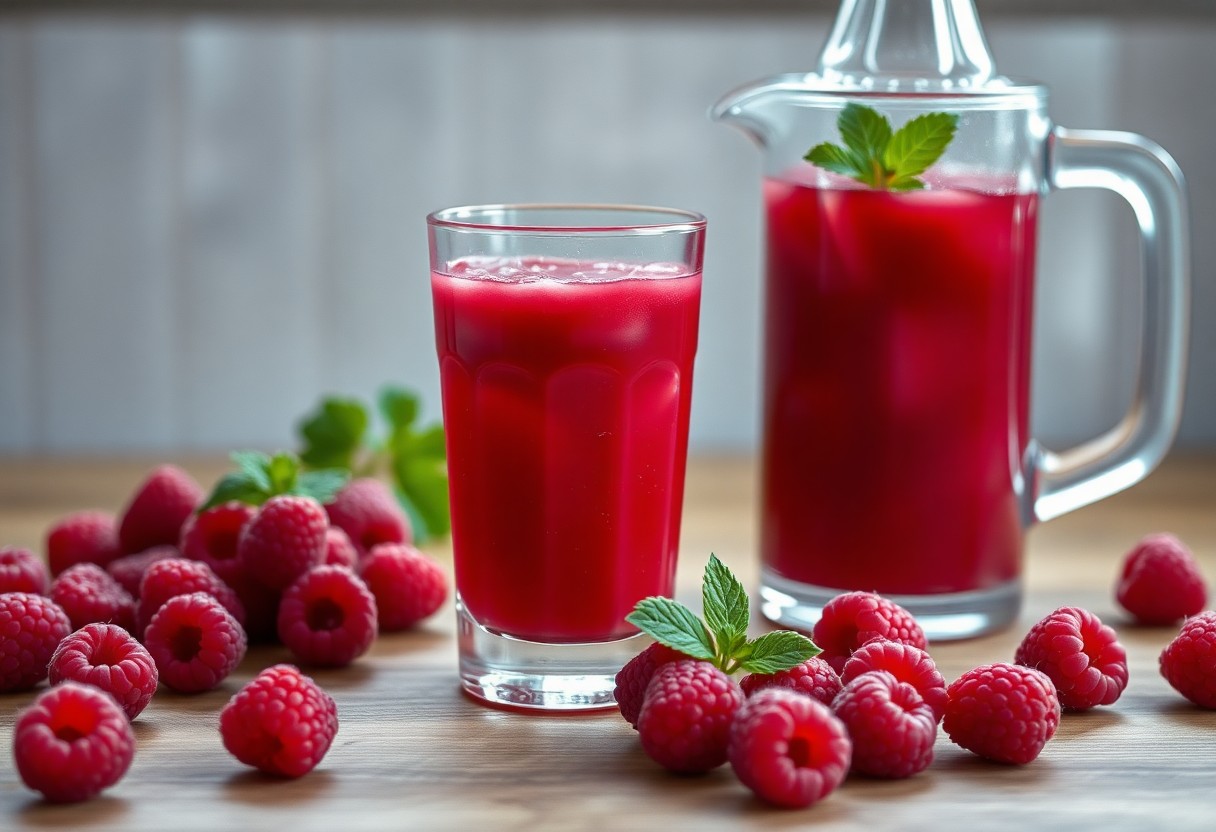There’s a delightful freshness that comes with juicing raspberries, but *you need* to know the right techniques to achieve the best results. These vibrant berries are packed with flavor and nutrients, but their delicate structure can make extraction tricky. By following a few simple tips, you can ensure that the juice retains its natural sweetness and vibrant color. In this post, you will discover how to maximize your raspberry yield and create delicious juice that is perfect for a variety of beverages and recipes.
Key Takeaways:
- Raspberries can be juiced, but it’s crucial to combine them with other fruits or vegetables for better extraction and flavor enhancement.
- Using a high-quality juicer or blender can help achieve a smoother consistency and maximize juice yield from raspberries.
- Straining the juice through a fine mesh or cheesecloth after blending can improve the texture and remove excess pulp, resulting in a refreshing drink.
Benefits of Juicing Raspberries
The benefits of juicing raspberries extend beyond their delicious taste. When you juice these vibrant berries, you unlock a concentrated source of nutrients, allowing you to easily incorporate their goodness into your diet. This can aid in hydration, provide crucial vitamins, and serve as a refreshing treat that’s both flavorful and beneficial for your health.
Nutritional Value
On average, one cup of raspberries contains approximately 65 calories and is packed with vital nutrients. You get a good dose of vitamin C, fiber, and antioxidants, making raspberry juice not only tasty but also a nutritious addition to your lifestyle. Consuming this juice can help you meet your daily vitamin requirements while adding a burst of flavor.
Health Benefits
Behind their tasty exterior, raspberries offer numerous health benefits that make juicing them worthwhile. They are known for their high antioxidant content, particularly ellagic acid, which may help protect your cells from damage. This, combined with their fiber-rich profile, supports digestive health and promotes a feeling of fullness, aiding in weight management.
Value your health by incorporating raspberry juice into your routine. It can provide anti-inflammatory properties and support your immune system due to its abundance of antioxidants. Additionally, the fiber in raspberries plays a significant role in maintaining gut health and regulating blood sugar levels, making it a smart choice for those looking to support their overall wellness.

Choosing the Right Raspberries
It’s important to select the right raspberries to enhance the flavor and quality of your juice. Look for berries that are vibrant in color, whether they are red or golden, and avoid those that show signs of over-ripeness or damage. Your goal is to find fresh, plump berries that will yield the best juice and flavor.
Fresh vs. Frozen
Along your journey to juicing, you may decide between fresh and frozen raspberries. Fresh raspberries offer unrivaled flavor and texture, making them ideal for immediate juicing. However, frozen raspberries can be a convenient option when fresh berries are out of season or if you want to store them for longer. Keep in mind that frozen berries may produce slightly different juice consistency but still deliver great taste.
Quality Indicators
Any time you are selecting raspberries, pay attention to quality indicators to ensure the best juicing experience. Look for berries that are firm, plump, and brightly colored. Avoid any that appear mushy, shriveled, or have a dull appearance. Signs of mold or excessive moisture are also red flags that indicate the berries are past their prime.
Further assessing quality, you should be aware that fresh raspberries should have a slight sheen and should be well-shaped, without any bruising. Inspecting the container for moisture can also help, as any condensation indicates possible spoilage. Lastly, a sweet aroma is a positive sign of ripeness, while a sour smell can indicate fermentation or decay. Selecting high-quality raspberries will ultimately lead to more flavorful juice, enhancing your juicing experience.
Equipment Needed for Juicing
After deciding to juice raspberries, you’ll need the right equipment to make the process smooth and effective. Start with either a juicer or a blender, depending on your preference, as both can help you extract the delicious flavor and nutrients from these berries. Additionally, you might want to consider accessories like a fine mesh strainer or cheesecloth to achieve a smoother juice consistency. Having the right tools ensures you achieve the best results and enjoy the juicing process.
Juicers vs. Blenders
Against popular belief, you can successfully juice raspberries using either a juicer or a blender. Juicers are designed to extract liquid efficiently, resulting in a clear juice with minimal pulp. In contrast, blenders will puree the raspberries, creating a thicker juice or smoothie. Your choice will depend on whether you prefer a clean juice or a more substantial drink.
Essential Accessories
Along with your juicer or blender, consider vital accessories to enhance your juicing experience. Using a fine mesh strainer or cheesecloth can help filter out pulp, producing a clearer juice. A measuring cup allows you to monitor your juice yield, while a slicing knife can assist in preparing your raspberries for juicing. Having these accessories on hand will make the process easier and improve the quality of your juice.
Equipment like a fine mesh strainer or cheesecloth is important when working with raspberries, as it helps remove excess pulp from the juice, giving you a smooth finish. A measuring cup can aid in portioning your yield, allowing you to create consistent batches. Utilizing a sharp knife to slice the berries before juicing not only saves you time but ensures you can effectively extract all the juice. Ensuring you have these vital accessories will significantly enhance your juicing experience and results.

Step-by-Step Juicing Process
Not all juicing methods are created equal, and following the right process can enhance the quality of your raspberry juice significantly. Here’s a simple table breaking down the juicing process:
| Step | Description |
|---|---|
| 1. Preparation | Wash and remove any stems from your raspberries. |
| 2. Choose Equipment | Select a juicer suitable for berries, such as a masticating juicer or blender. |
| 3. Juice | Process your raspberries through the juicer. |
| 4. Strain | Optional: strain the juice for a smoother consistency. |
| 5. Enjoy | Serve fresh or store in the fridge. |
Preparation of Raspberries
An effective juicing experience starts with proper preparation. Begin by washing your raspberries thoroughly in cold water to remove any dirt or pesticides. It’s also important to inspect the berries, discarding any that are moldy or overly soft. This will ensure you only use the freshest fruit, which will directly impact the flavor and quality of your juice.
Juicing Techniques
Process your raspberries wisely for the best yield. You can use either a masticating juicer, which extracts juice slowly, preserving more nutrients, or a high-speed blender for a quicker method. Adding a small amount of water can help facilitate the juicing process if you choose a blender. This additional liquid can enhance the extraction and make your juice smoother.
Hence, understanding the right techniques can make all the difference in your raspberry juicing efforts. If you choose a blender, you may want to blend just until smooth, avoiding over-processing, which can lead to excessive pulp. Conversely, with a masticating juicer, you’ll notice that it efficiently extracts juice without too much pulp. Additionally, always use fresh, ripe raspberries for maximum flavor and nutrition—don’t risk your juice quality by using old or unhealthy fruit!

Tips for Enhancing Raspberry Juice
Despite the natural sweetness and vibrant flavor of raspberries, you can still enhance your raspberry juice experience. Consider these tips for the best results:
- Add a splash of lemon juice for brightness.
- Incorporate mint leaves for freshness.
- Mix in other fruits like strawberries or blueberries for complexity.
- Chill your juice before serving to elevate the taste.
This combination of flavors and techniques can elevate your raspberry juice to new heights.
Flavor Combinations
The easiest way to enhance your raspberry juice is to experiment with different flavor combinations. Mix raspberries with watermelon for a refreshing twist, or pair them with citrus fruits like lemons or limes to create a tangy blend. You can also consider combining raspberries with ginger for added spice or blending them with apples for a sweeter taste. The possibilities are endless!
Sweetening Options
For those who prefer a sweeter drink, there are several great options to sweeten your raspberry juice. Natural sweeteners like honey and agave syrup can enhance the flavor without overpowering the fruity notes. Consider using stevia or maple syrup for a more unique taste. You can also incorporate granulated sugar if you desire a classic sweetness. Making the right choice can help achieve the perfect balance, enhancing your juice.
Juice from raspberries often has a tart flavor, and adding sweeteners can significantly transform the overall taste. It’s important to choose options that complement the natural flavor of raspberries. Using too much sugar or syrup can mask the delicious berry notes. You can start with a small amount of honey or agave syrup and adjust according to your preference. Be mindful of how these sweeteners interact with your raspberry juice; aim for a harmonious blend that highlights the raspberry flavor rather than overwhelming it.
Storing Raspberry Juice
Many people enjoy making raspberry juice, but understanding how to store it properly is key to preserving its flavor and quality. Always use clean, sterilized containers to store your juice, and consider refrigeration for short-term storage or freezing for longer shelf life. Ensure your containers are opaque or dark glass to protect against light, which can degrade the nutrients and taste of your juice.
Best Practices
Practices like using airtight containers and keeping your juice in the coldest part of your refrigerator can significantly extend its freshness. For optimal preservation, consider freezing your raspberry juice in ice cube trays, allowing you to use smaller portions as needed without compromising the entire batch.
Shelf Life
On average, homemade raspberry juice can last about 3 to 5 days in the refrigerator, while frozen juice can stay fresh for up to 6 months.
Due to the natural sugars and acids in raspberry juice, it is prone to fermentation and spoilage if not stored correctly. Always check for signs of spoilage, such as an off smell or separation. Using proper storage techniques will help maintain your raspberry juice’s delicious flavor and nutritional benefits for as long as possible. Keep an eye on expiration dates for store-bought versions, as they may have different preservatives affecting their longevity.
Final Words
Taking this into account, juicing raspberries can be a rewarding process that yields delicious results. By selecting ripe fruit, opting for the right juicing method, and experimenting with combinations, you can enhance your raspberry juice experience. Ensure cleanliness during preparation and storage to preserve flavor and freshness. With these tips, you’re well-equipped to enjoy vibrant and flavorful raspberry juice, perfect for hydration or as an ingredient in various recipes.
FAQ
Q: Can you juice raspberries?
A: Yes, you can juice raspberries! Raspberries have a high water content and a rich flavor, making them a great choice for juicing. You can use a juicer or a blender to extract the juice. Be sure to strain the juice if you prefer a smoother consistency, as raspberries contain tiny seeds that may affect the texture.
Q: What is the best way to prepare raspberries for juicing?
A: Start by washing the raspberries gently under cool water to remove any dirt or pesticides. If you notice any damaged or moldy berries, discard them. You don’t need to remove the stems, as they will not affect the juicing process. For optimal flavor, choose ripe raspberries, as they will yield the best results.
Q: Should I mix raspberries with other fruits or vegetables when juicing?
A: Mixing raspberries with other fruits and vegetables can enhance their flavor and nutritional value. Combining them with sweeter fruits like apples or pears can balance the tartness, while adding greens like spinach or kale can boost the health benefits. Experiment with different combinations to find a blend that you enjoy!
Q: How can I enhance the flavor of raspberry juice?
A: To enhance the flavor, consider adding a squeeze of citrus juice, like lemon or lime, which can brighten the taste. You can also sweeten the juice with honey, agave syrup, or maple syrup. For an herbal twist, try infusing your juice with mint or basil for a refreshing kick.
Q: How should I store leftover raspberry juice?
A: Store leftover raspberry juice in an airtight container in the refrigerator. It’s best to consume it within 2-3 days for optimal taste and nutrition. If you want to keep the juice longer, consider freezing it in ice cube trays. This will allow you to use the juice in various recipes without waste.
